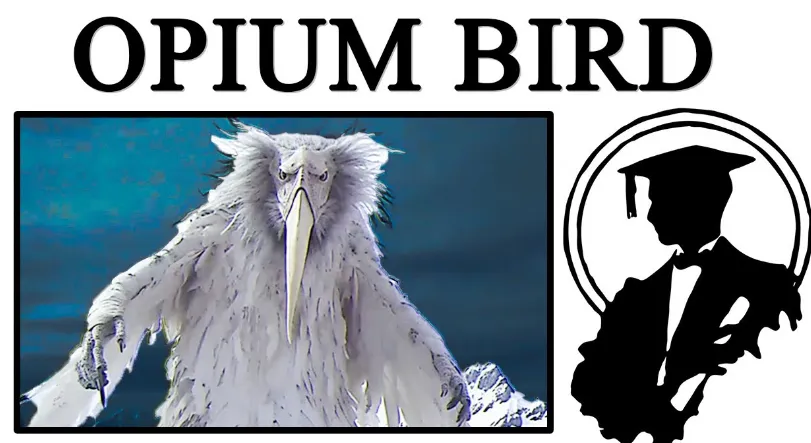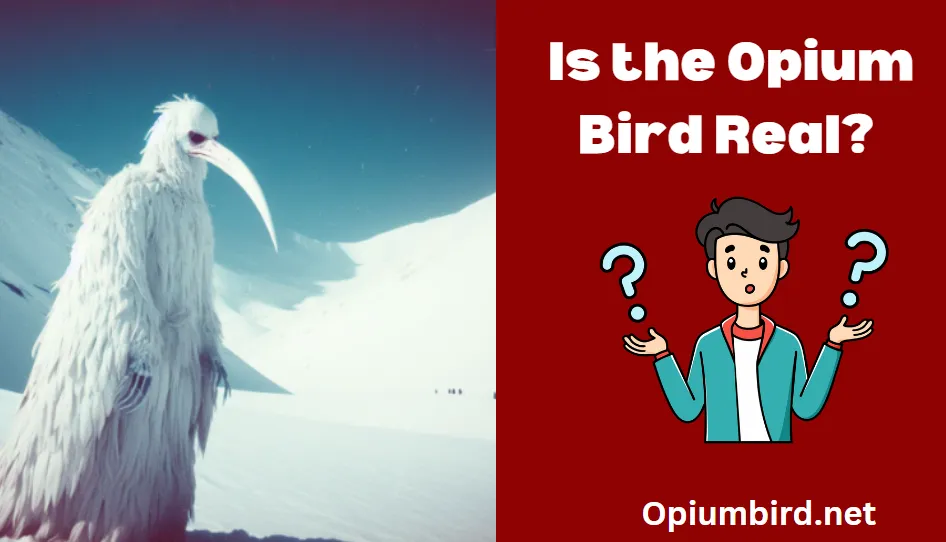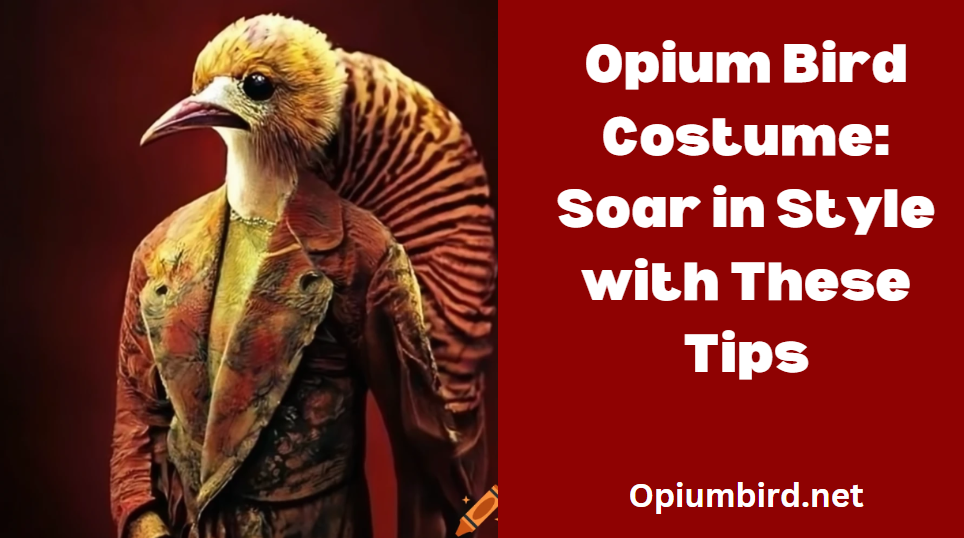The Opium Bird, also known as the Opium-eater, is a fictional creation. It symbolizes addiction and the consequences of opium consumption.
Opium Bird is a term rooted in literature and cultural symbolism, often depicting the destructive nature of addiction. Originating from the writings of Thomas De Quincey in his work “Confessions of an English Opium-Eater,” the Opium Bird serves as a metaphor for the entrapment and allure of opium.
This symbol highlights the psychological and physical toll that addiction can take on individuals. In modern discussions, the Opium Bird continues to represent the broader impacts of substance abuse, reminding readers of the importance of awareness and intervention. Understanding this concept helps in grasping the historical and cultural dimensions of addiction.
The Enigma Of Opium Birds

The Opium Bird, an elusive creature, has fascinated people for centuries. Its mysterious nature and rare sightings create an aura of intrigue. Let’s delve into the enigma of Opium Birds and uncover the truths hidden beneath layers of myth and legend.
Myth Vs. Reality
Opium Birds have been subjects of many myths. Some believe they possess magical powers. Others think they bring good luck or misfortune. These birds are often linked to ancient folklore.
In reality, Opium Birds are rare but very real. They are not mythical creatures. Scientists have studied them to understand their behaviors and habitats. They have unique patterns and vibrant colors, making them stand out.
Despite the myths, the Opium Bird is a natural marvel. Its mystique lies in its rarity and striking appearance. Understanding the difference between myth and reality helps appreciate this extraordinary bird.
Origins Of The Opium Bird
The mystique of the Opium Bird has deep roots. Ancient cultures revered them for their beauty and rarity. They often featured in art and literature, symbolizing various qualities.
Historical texts describe encounters with Opium Birds. These descriptions added to their legendary status. People saw these birds as omens or symbols of divine messages.
In modern times, the rarity of Opium Birds continues to fuel their mystique. Bird watchers and nature enthusiasts seek them out, hoping for a rare glimpse. This ongoing fascination keeps the legend of the Opium Bird alive.
Understanding the origins of their mystique helps appreciate their place in culture and nature. The blend of history, art, and nature creates a rich tapestry around these fascinating birds.
History of the Opium Bird
The Opium Bird, a fascinating creature, has intrigued humans for centuries. Its unique behaviors and characteristics have woven it into various aspects of human culture and history. Let’s dive into the historical references and cultural significance of this remarkable bird.
Historical References
The Opium Bird appears in many ancient texts. It is often depicted in old manuscripts and carvings.
In ancient China, the bird symbolized wisdom. Scholars wrote poems and stories about its mysterious nature. Ancient Egyptians also admired the bird. They believed it had magical powers.
Medieval Europe has numerous references to the Opium Bird. Artists painted it in their works. Writers included it in their tales of wonder and fantasy. The bird was a symbol of mystery and intrigue.
Cultural Significance
The Opium Bird holds a special place in many cultures. It represents different things to different people.
In Asian cultures, the bird is a symbol of peace and tranquility. People believe it brings good luck and harmony. Festivals often feature the bird in their celebrations.
In African folklore, the Opium Bird is a messenger. Stories tell of the bird carrying messages between the living and the spirits. It is considered a bridge between worlds.
Native American tribes also revere the Opium Bird. They see it as a guardian spirit. The bird appears in many tribal rituals and ceremonies.
Here is a table summarizing the cultural significance of the Opium Bird in different regions:
| Region | Symbolism |
| Asia | Peace and Tranquility |
| Africa | Messenger between Worlds |
| Native America | Guardian Spirit |
The bird’s cultural impact is vast and diverse. Its presence in history enriches our understanding of human culture and beliefs.
Biology Of The Alleged Opium Bird
The Opium Bird remains a mystery in the animal kingdom. Known for its elusive nature, this bird intrigues many. Below, we explore its biology in detail.
Physical Characteristics
The Opium Bird boasts striking features. Its feathers display a range of colors, from deep blues to vibrant reds. These colors help it blend in with its surroundings.
It has a slender body, which aids in swift flight. The beak is sharp and slightly curved, perfect for its diet. The eyes are large and keen, giving it excellent vision.
Here is a quick look at its physical traits:
| Feature | Description |
| Feather Color | Deep blues to vibrant reds |
| Body Shape | Slender |
| Beak | Sharp and curved |
| Eyes | Large and keen |
Habitat And Behavior
The Opium Bird prefers dense forests. These environments provide ample cover and food. It builds nests high in the trees, safe from predators.
This bird is primarily nocturnal. It becomes active at dusk and hunts for food throughout the night. Its diet consists mainly of insects and small mammals.
Here are some interesting behavioral traits:
- Nocturnal habits
- Nest building in high trees
- Diet of insects and small mammals
Understanding the Opium Bird’s biology is key to conserving its habitat. Protecting these birds ensures biodiversity remains intact.
The Opium Connection
The opium connection between the Opium Bird and the poppy plant is fascinating. This unique relationship draws interest from both bird enthusiasts and botanists. The bird’s behavior around the poppy is a spectacle worth exploring.
Why ‘opium’?
The Opium Bird gets its name from its peculiar affinity for the opium poppy. Unlike other birds, it has a special attraction to this plant. This connection is not just a coincidence.
Opium poppies are rich in alkaloids. These chemicals influence the bird’s behavior. The bird seems to have developed a taste for the poppy’s seeds. The seeds may contain trace amounts of these alkaloids.
The Bird And The Poppy
The interaction between the Opium Bird and the poppy is unique. This bird is often seen around fields of opium poppies. It can be observed pecking at the seeds. This behavior is not common in other birds.
Research shows that the bird’s diet includes these seeds. Consuming them in small amounts does not harm the bird. Instead, it seems to enjoy them. This relationship is a subject of ongoing study.
Here is a table summarizing the key points:
| Aspect | Details |
| Bird Name | Opium Bird |
| Plant Involved | Opium Poppy |
| Main Attraction | Poppy Seeds |
| Chemical Influence | Alkaloids |
Key points to remember:
- The Opium Bird has a special attraction to the opium poppy.
- It consumes the seeds, which contain alkaloids.
- This unique relationship is studied by scientists.
Conservation Status
The Opium Bird, a rare and fascinating species, faces several challenges in the wild. Its numbers have been dwindling due to various factors. Understanding its conservation status is crucial for its survival.
Threats To Survival
Several threats contribute to the decline of the Opium Bird population:
- Habitat loss: Deforestation and urbanization destroy the bird’s natural habitat.
- Illegal hunting: Poaching for feathers and meat has reduced their numbers significantly.
- Climate change: Altered weather patterns disrupt their breeding and feeding habits.
- Pesticides: Chemicals used in agriculture poison their food sources.
Conservation Efforts
Efforts to conserve the Opium Bird are underway:
- Protected areas: Establishing reserves helps safeguard their habitats.
- Anti-poaching laws: Strict regulations aim to reduce illegal hunting activities.
- Breeding programs: Conservationists work on captive breeding to boost population numbers.
- Community awareness: Educating locals on the importance of conservation fosters a supportive environment.
Here’s a table summarizing the key threats and conservation efforts:
| Threats | Conservation Efforts |
| Habitat loss | Protected areas |
| Illegal hunting | Anti-poaching laws |
| Climate change | Breeding programs |
| Pesticides | Community awareness |
Conserving the Opium Bird requires a unified effort. Every action taken today helps secure a future for this amazing species.
In Search Of The Opium Bird
The Opium Bird is a mysterious creature often mentioned in legends. People have been fascinated by this bird for centuries. Many have embarked on journeys to find it.
Expeditions And Sightings
Several explorers have ventured into dense forests and remote areas. They hope to catch a glimpse of the Opium Bird. These expeditions are often filled with excitement and danger.
In 1920, an explorer named John Smith reported seeing the Opium Bird. He described it as having vibrant, colorful feathers. Another sighting occurred in 1950 by a group of hikers. They claimed the bird had a unique, melodic call.
Some expeditions have even led to the creation of detailed maps. These maps highlight areas where the bird was allegedly seen. Enthusiasts use these maps to plan their own trips.
Evidence And Hoaxes
Many people have tried to provide evidence of the Opium Bird’s existence. This includes photographs, feathers, and even recorded sounds. Some pieces of evidence have been convincing at first glance.
Unfortunately, not all evidence is genuine. There have been numerous hoaxes over the years. In 1985, a man claimed to have captured the bird. It turned out to be a clever fake, designed to attract attention.
Distinguishing between real evidence and hoaxes can be challenging. Enthusiasts continue to analyze new findings. They hope to one day confirm the existence of the Opium Bird.
| Year | Event | Outcome |
| 1920 | John Smith’s Sighting | Unverified |
| 1950 | Hikers’ Sighting | Unverified |
| 1985 | Fake Capture | Hoax |
The search for the Opium Bird continues. Many dream of being the first to provide undeniable proof. Each new expedition brings hope and excitement.
Cultural Impact And Beliefs
The Opium Bird has captured human imagination for centuries. This mysterious creature appears in many cultural tales. Its symbolism varies across different societies. From ancient texts to modern stories, the Opium Bird leaves a lasting impact.
In Literature And Art
Writers and artists often feature the Opium Bird in their works. In ancient myths, it symbolizes transformation and enlightenment. Medieval poets described it as a guide to hidden truths.
In paintings, the Opium Bird often appears in dream-like settings. Artists use vivid colors to depict its otherworldly nature. Sculptors have also crafted intricate statues of the Opium Bird, showcasing its elegance.
| Medium | Representation |
| Literature | Symbol of transformation |
| Paintings | Dream-like settings |
| Sculptures | Intricate designs |
Modern Day Interpretations
Today’s interpretations of the Opium Bird are diverse. In films, it often represents mystery and the unknown. Fantasy novels depict it as a creature of immense power.
Many people see the Opium Bird as a symbol of personal growth. Some believe it helps in overcoming obstacles. Others view it as a sign of hope and renewal.
- Films: Mystery and the unknown
- Novels: Creature of immense power
- Personal Growth: Symbol of overcoming obstacles
- Renewal: Sign of hope
Exploring The Truth
The Opium Bird has long fascinated many. Its name evokes mystery and wonder. But what is the real story behind this enigmatic bird? In this section, we will uncover the truth through scientific investigations and demystifying the legend.
Scientific Investigations
Scientists have studied the Opium Bird for years. They have conducted numerous field studies and lab tests. The results are surprising and enlightening.
Field Studies:
- Researchers observed the bird’s habitat.
- They recorded its feeding patterns.
- The bird was found near poppy fields.
Lab Tests:
- Feathers were analyzed for chemical residues.
- DNA tests were conducted to understand its lineage.
- The bird’s diet was studied through stomach content analysis.
These scientific investigations provided a clearer picture. The Opium Bird is not just a myth. It interacts with its environment in unique ways.
Demystifying The Legend
The legend of the Opium Bird is filled with fantasy. It is said to bring dreams and visions. Let’s separate fact from fiction.
Origins of the Legend:
| Aspect | Legend | Reality |
| Appearance | Glows in the dark | Has iridescent feathers |
| Behavior | Sings lullabies | Has a unique call |
| Habitat | Lives in mystical forests | Found near poppy fields |
People often weave stories around what they don’t understand. The Opium Bird is no exception. But scientific findings help demystify these legends. The bird’s unique traits inspire myths, but reality is fascinating too.
Frequently Asked Questions
Are Birds Hooked On Opium?
Some birds in India consume opium from poppy fields. They develop a dependency and return regularly for more.
What Is The Opium Bird In Siberia?
The opium bird in Siberia is the waxwing. They eat fermented berries, which can make them appear intoxicated. This behavior has led to their nickname.
What Is An Opium Bird?
An Opium Bird is a term used to describe a bird that has been observed interacting with opium poppies, often consuming the seeds or nectar.
Why Are Opium Birds Significant?
Opium Birds are significant because their behavior provides insight into the ecological impact of opium poppy cultivation.
Conclusion
The Opium Bird remains a captivating subject in ornithology. Its unique behaviors and habitat intrigue bird enthusiasts worldwide. Understanding this bird can help with conservation efforts. Keep exploring and learning about these fascinating creatures. Dive deeper into the world of birds to appreciate their role in our ecosystem.




